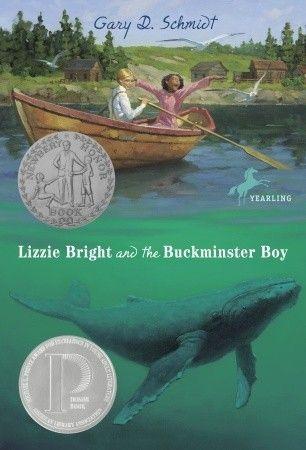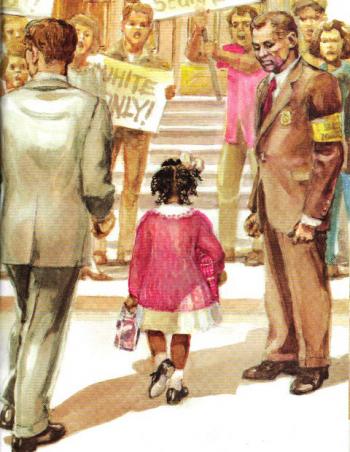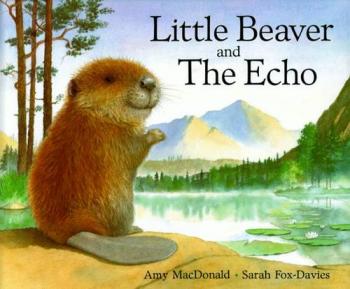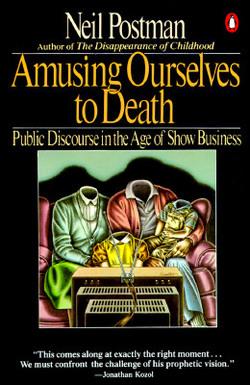
scrounge: /skrounj/ informal verb: to actively seek [books] from any available source

Book Scrounger's note: The following is a guest review by Doug, a.k.a. Professor Puzzler.
So many books I read end up getting lost in the recesses of my mind, and if you asked me sixth months later what I had read, I wouldn't be able to tell you much about the book. Lizzie Bright and the Buckminster Boy will, I think, stay with me for a very long time. This is the story of a friendship between a preacher's son and a pauper black girl from a small island off the coast of Maine.
My wife found the book at Goodwill, and bought it because it takes place in our home state, and because it is a Newbery Honor book.
I started reading it and was hooked from the very first page. The main characters (Lizzie Bright and Hunter Buckminster III) are such believable characters, and I had a sense -- which I seldom get from fictional books -- that these were real, honest-to-goodness people. My perceptions were shaped, perhaps, by the fact that I'm from Maine, and know the places described in the book.
But it wasn't until I was several chapters in that I suddenly realized that this book was only partly fictional. It is the story of one of Maine's most shameful historic events. It is the story of Malaga Island, and the state's decision to remove the island's slave-descended and mixed-race residents and place them in a home for the feeble-minded, where they lived out the remainder of their tragic lives.
Here are some of the things that I loved about this book:
- The descriptions of the Maine coast, community, and church life.
- Believable character interactions and ever changing relationships.
- In keeping with #2, a recurring theme of forgiveness (not explicitly mentioned, but clearly evident).
- Characters who don't always do exactly what you expected them to.
- The depictions of human selfishness, along with selflessness and courage.
- The sprinkling of humorous moments and funny dialogue in the midst of a difficult story.
When I see "Newbery Honor," I automatically think, "book for kids," but this is a book for older kids. It has also won "young adult" awards. The story, being based around tragic historic events, is very dark at times, and as you can probably deduce from what I've said so far, does not have a happy ending.
But it is a powerful book, and it deserves a place in your reading list. There is much more I could say about the book, but I don't want to spoil too much of it for you, so I'll stop here.
I have a feeling this will be one of those rare books that I'll come back to someday and read for a second -- maybe even a third time.
Scrounged From: Our local Goodwill store
Format: Paperback
Author: Gary D. Schmidt
Pages: 224
Content Advisory: Some violence, and depictions of white supremacist attitudes and actions.

Book Scrounger's note: The following is a guest review by Doug, a.k.a. Professor Puzzler.
The Story of Ruby Bridges is a children's book which tells the story of the desegregation of William Frantz Elementary School in New Orleans. The story focuses primarily on Ruby's bravery, her faith, and her desire to find forgiveness for the mobs of angry people who wanted to stop her from attending the school.
Speaking of the mobs, author Robert Coles does an excellent job of describing the troubles that Ruby faced, at an age-appropriate level for a children's book. He speaks of angry mobs, and shouting, and protest signs, and of people wanting to hurt Ruby, but avoids discussing any of the specifics of the threats she faced. I liked this choice on the author's part, as it gives parents the freedom to discuss the more vicious aspects of the story when they feel it is most appropriate for their own children.
Robert Coles was probably best suited of anyone to write this book, as he was the child psychiatrist who met weekly with Ruby during her first year at Frantz Elementary. His work with Ruby led him, eventually, to write a book titled Children of Crisis: A Study of Courage and Fear, which he eventually developed into a series of books that won him the Pulitzer Prize in 1973.
Of course, any children's book is dependent not just on the author, but also on the illustrator; an illustrator can make or break a book. In this case, George Ford is an integral part of making this book a success. The illustrations are beautiful, with great use of light, shadow and coloration to draw attention to the focus of the book -- Ruby herself. Whether she is sitting alone in a classroom, with her family at church, or dwarfed by an angry mob and the marshals protecting her, it is always Ruby that captures your eye.
Scrounged From: Our local library
Format: Hardcover
Author: Robert Coles
Illustrator: George Ford
Pages: 32
Content Advisory: Thematic elements, as described above.

Book Scrounger's note: The following is a guest review by Doug, a.k.a Professor Puzzler:
I just wrote a book review for Little Beaver and the Echo; this is another book that I absolutely love the pairing of text (by Sherri Duskey Rinker) and illustrations (by Tom Lichtenheld). As a matter of fact, in Goodnight, Goodnight, Construction Site, I would say that I like the illustrations more than the text. Don't get me wrong, I do like the text -- although there are some rhythmic stumbles in the poetry that caught me off-guard the first couple times I read it. But when I'm reading this book to my kids, I'm barely paying attention to the words I'm reading, because I'm looking at all those delightful illustrations.
The use of color is great, and in particular, the illustrator used different tinted papers for the various "times of day" illustrations, which resulted in all the daytime pictures, all the sunset pictures, and all the nighttime pictures each having the appropriate color warmth to them, because each shared a base color.
The story (which isn't really a story; there's no real plot to the book) focuses on the activities of five construction vehicles: a crane truck, a cement mixer, a dump truck, a bulldozer, and an excavator. Each machine (you can see the excavator in the picture here) has its own unique personality and facial features. Each vehicle has a section of the book, ending with the vehicle snuggling up for a good night's sleep after a long day's work. After each section, the book ends with a couple pages of wishing the team a good night.
If you have young children who are fascinated with construction vehicles, you should not be without this book!
Scrounged From: Amazon, for our four-year-old
Format: Hardcover
Author: Sherri Duskey Rinker
Illustrator: Tom Lichtenheld
Pages: 32
Content Advisory: None

Book Scrounger's note: The following is a guest review by Doug, a.k.a. Professor Puzzler.
Little Beaver and the Echo is a wonderful picture book that tells the story of a lonely little beaver who -- while crying about how lonely he is -- hears a voice from across the pond crying about the same thing. Surprised, he sets off in his canoe to see if he can find that lonely little animal on the other side of the pond.
Along the way he makes new friends, and learns that the creature on the other side of the pond has also made new friends. It's a wonderful story about the simplicity with which friendships can be discovered, formed, and cultivated.
My children enjoy the story, and I love the combination of text and beautiful artwork.
This fall I took my 4-year-old son to a "kinderkonzert" -- a concert for children. We chose to go specifically because the concert was going to involve the telling of the story of Little Beaver and the Echo. What I didn't know was that the author, Amy MacDonald, was going to be present, and would be narrating the story herself. That was a wonderful surprise.
After the concert, my son and I spoke with her for a few minutes, and told her how much we enjoyed her book. I said, "And it's not just the story -- you had a wonderful illustrator to work with for this book!"
Her response: "Yes, I consider myself quite blessed in the choice of illustrators."
Blessed indeed. The combination of text and illustrations is delightful. I just found out, while writing this review, that there is a sequel to this book: Little Beaver and the Big Front Tooth, with the same illustrator!
Scrounged From: A gift to our two-year-old
Format: Paperback
Author: Amy MacDonald
Illustrator: Sarah Fox-Davies
Pages: 32
Content Advisory: None

Book Scrounger's note: The following is a guest review by Doug, a.k.a. Professor Puzzler:
In 1985, Neil Postman wrote a frightening and prophetic book called Amusing Ourselves to Death, in which he analyzed the state of public discourse in the United States. In fact, he subtitled his book, "Public Discourse in the Age of Show Business."
This book should be required reading for all students before graduating high school.
In his foreword to the book, Postman explains the difference between Aldous Huxley's Brave New World and George Orwell's 1984 and then he writes, "What Orwell feared were those who would ban books. What Huxley feared was that there would be no reason to ban a book, for there would be no one who wanted to read one..." and "This book is about the possibility that Huxley, not Orwell, was right."
From there Neil Postman goes on to argue persuasively that we are becoming a society which would rather be entertained than informed, and that more and more the media will pander to our desire for entertainment, until we reach the point that all conversation is "sound bite conversation."
To me, the most extraordinary thing about this book is that Postman wrote it when the internet was in its infancy, and the concept of "social media" hadn't even entered anyone's minds. And yet, everything Postman wrote about in 1985 describes perfectly where we are as a society in 2016. Nobody wants to think deep thoughts or read in-depth analysis of anything. The basic premise of our society is: "If it can't be expressed as a facebook meme," it's not worth considering.
Postman, on the other hand, would probably have argued, "If it can be expressed as a facebook meme, it has been robbed of any surrounding context and is therefore good purely for entertainment." And even though Postman could not have predicted social media, he predicted the effect it is having on our society: it has become the cornerstone of our hunger for entertainment over understanding.
And it's not just reading, it's also listening. Postman writes about the Lincoln-Douglas debates, in which presidential candidates debated policy for three hours straight, took a one-hour break for supper, and then continued three more hours. And the hall was packed with spectators. Imagine that! People thought it was worth their time to sit and listen to people argue policy for six hours in one day! Today, debates have become circuses in which we're more interested in watching a trainwreck than listening to anything substantive.
It reminds me of a quote which is often (and probably incorrectly) attributed to Mark Twain: "The person who does not read has no advantage over the person who cannot read." We have become a society that can't be bothered to learn, study, read, and understand. And so we are no better than a society that can't do any of those things.
Format: Paperback
Author: Neil Postman
Pages: 163
Content Advisory: None


